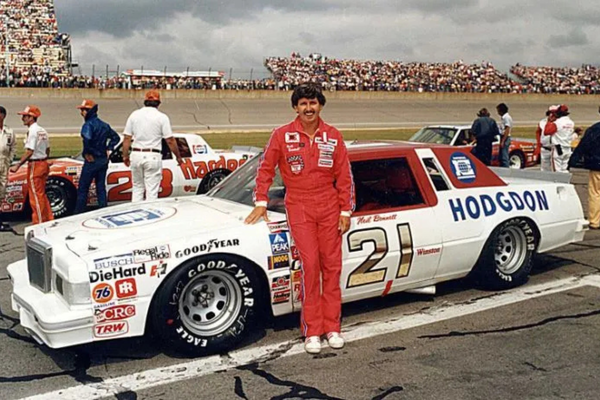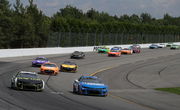

On February 11, 1994, everything in NASCAR came to a halt. A practice crash at Daytona had claimed the life of Neil Bonnett, the smiling native of Alabama with a voice that warmed millions of living rooms and a firebrand driving style. He was taken by the circuit he had previously mastered, and the sport lost much more than simply a driver in the process. A heritage that is ingrained in NASCAR’s very fabric may be found beneath the helmet, outside the pit box, and away from the broadcast booth.
There was more to Bonnett’s narrative than the wins on his stat sheet or the number on his car. Loyalty—to his family, his supporters, and the legendary Alabama Gang—was at the center. It was about perseverance, as he reinvented himself behind the microphone after suffering horrifying injuries and then returning to racing. And it had to do with heart—the kind that, when his name was said, made even his most ardent opponents grin.
ADVERTISEMENT
Article continues below this ad
Who was Neil Bonnett?
A proud member of the storied Alabama Gang, Neil Bonnett was a tough and joyful NASCAR driver and, later, one of the sport’s most adored broadcasters. Under the guidance of Bobby and Donnie Allison, Bonnett, who was born in Hueytown, Alabama, on July 30, 1946, advanced through the ranks and raced with a strong, blue-collar style that was characteristic of Southern stock car heritage. Driving for dominant teams like Wood Brothers Racing and Junior Johnson & Associates, Bonnett recorded 18 Cup Series victories during his career, including historic triumphs at Talladega, Charlotte, and Richmond. Peers like Dale Earnhardt, with whom he had a close friendship and a bitter competition on the track, respected him for his aggressive yet clean racing style.

Following a horrific collision at Darlington that almost ruined his career, Bonnett moved into broadcasting with CBS and TNN in the late 1980s. Few people could get fans closer to the sport than he because of his genuine charisma, great racing knowledge, and charming Southern drawl. But tragically, Bonnett died in a crash during Daytona 500 practice in 1994, following a brief comeback in 1993. For the NASCAR community, his passing was a devastating blow. His legacy endures, nevertheless, as a voice that gave the sport its personality and as a driver who gave his all on the track.
What’s your perspective on:
Did Neil Bonnett's legacy in NASCAR surpass his achievements on the track? Share your thoughts!
Have an interesting take?
Neil Bonnett’s NASCAR records and being part of the Alabama Gang
With 18 career Cup Series wins and 20 poles in 362 appearances, Neil Bonnett left a lasting legacy in NASCAR. He drove for Harry Hyde to his first victory at Richmond in 1977, but he found his footing with teams like Wood Brothers Racing and Junior Johnson & Associates. Bonnett achieved several notable triumphs, like as consecutive World 600 victories at Charlotte (1982–1983) and victories at Talladega Superspeedway, a venue that is known for the Alabama Gang’s supremacy.
Beyond the Cup Series, Bonnett demonstrated his abilities by winning the International Race of Champions (IROC), where he faced the best drivers in the world, and the Busch (now Xfinity) Series. His reputation was built on grit, sportsmanship, and consistency rather than merely trophies. He placed fourth in the Cup Series points standings in 1985, although he finished in the top 10 five other times. Neil starred in the movies Days of Thunder (1990) and Stroker Ace (1983). However, the story of Neil Bonnett would not be complete without mentioning the Alabama Gang, a close-knit racing community from Hueytown, Alabama, headed by Bobby and Donnie Allison.
Despite not being an initial member, Bonnett was its most well-known apprentice. He soon became a “brother” in both rivalry and friendship under Bobby Allison’s tutelage. Together, they established a tradition of devotion, quickness, and Southern pride while also putting Hueytown on the racing map. Bonnett was a pillar of a time when racing was unadulterated, intimate, and very local, whether he was driving or hanging out with the Allisons. His connection to the Alabama Gang made him as much a part of NASCAR’s culture as any victory could ever be.
Trending
Neil Bonnett’s transition from NASCAR to broadcasting
Neil Bonnett’s transition from race car to broadcast booth was more than just a job change; it was a resilient rebirth. Doctors urged him to quit competitive racing after a severe collision at Darlington Raceway in 1990 left him with severe head damage and memory loss. Unaffected by circumstances, Bonnett, however, discovered a fresh method to remain involved in the sport he loved.
He brought the same charm and genuineness that made him a track favorite to his new roles as a color analyst on CBS and TNN. He was immediately approachable due to his profound knowledge of the sport, which he conveyed with a sharp sense of humor and a charming Southern drawl. In addition to calling the races, he provided explanations, frequently sharing driver psychology, technical details, and insider stories that only a person with his level of knowledge could.

Furthermore, Bonnett hosted the well-received TNN program “Neil Bonnett’s Winners,” where he conducted casual, one-on-one interviews with drivers. Rare looks into the people behind the helmets were provided by the show, and Bonnett’s laid-back appeal made each episode more like a conversation than a presentation. Because he was more than simply a commentator, Bonnett had a way of getting drivers to open up, whether they were up-and-coming talent or seasoned pros.
But his passion for racing persisted. He made a brief return in 1993, competing in a few races for Dale Earnhardt’s squad. However, Bonnett discovered a second home in front of the camera, which was equipped with a microphone rather than a steering wheel. By doing this, he not only continued his NASCAR heritage but also contributed to the emergence of a new era of interesting, approachable racing coverage that connected the garage and the fans.
ADVERTISEMENT
Article continues below this ad
Neil Bonnett’s unfortunate demise and his lasting legacy
Neil Bonnett hopped into his No. 51 Country Time Chevrolet for a standard practice drive at Daytona International Speedway on February 11, 1994, a few days before the Daytona 500. What transpired was far from ordinary. In Turn 4, an unexpected mechanical failure slammed his car into the wall. The terrible and horrific crash rocked the NASCAR community to its foundation. After a four-year break due to his horrific 1990 Darlington crash, Bonnett had just recently resumed racing. His comeback was about demonstrating that he still had something to offer despite suffering life-altering injuries, not just about competing. His passing was all the more tragic because of that spirit. In addition to losing a driver, they also lost a friend, a parent, a mentor, and one of the most adored figures in the sport.
His death added to the gloom that surrounded Speedweeks in 1994, as he passed away just one day before the untimely death of young driver Rodney Orr. NASCAR had to face harsh realities regarding safety, and Bonnett’s passing was a part of an agonizing but essential discussion that would eventually lead to advancements in crash protection, head restraints, and vehicle design. Even though he died in the collision, his legacy was unaffected.
ADVERTISEMENT
Article continues below this ad
As a racer’s racer, Neil Bonnett is seen as aggressive yet respected, fearless yet amiable. He was a founding member of the Alabama Gang, a pioneer in broadcasting, and a confidant of Dale Earnhardt and other superstars. For a while, his son David Bonnett carried the family name into NASCAR, and his influence is still remembered in tributes around the sport, ranging from memorial decals to the moving recollections of those closest to him. Neil Bonnett is the history of NASCAR, not just a part of it. A symbol of the sport’s eternal heart, a link between generations, and a storyteller.
ADVERTISEMENT
ADVERTISEMENT
ADVERTISEMENT
ADVERTISEMENT






Did Neil Bonnett's legacy in NASCAR surpass his achievements on the track? Share your thoughts!